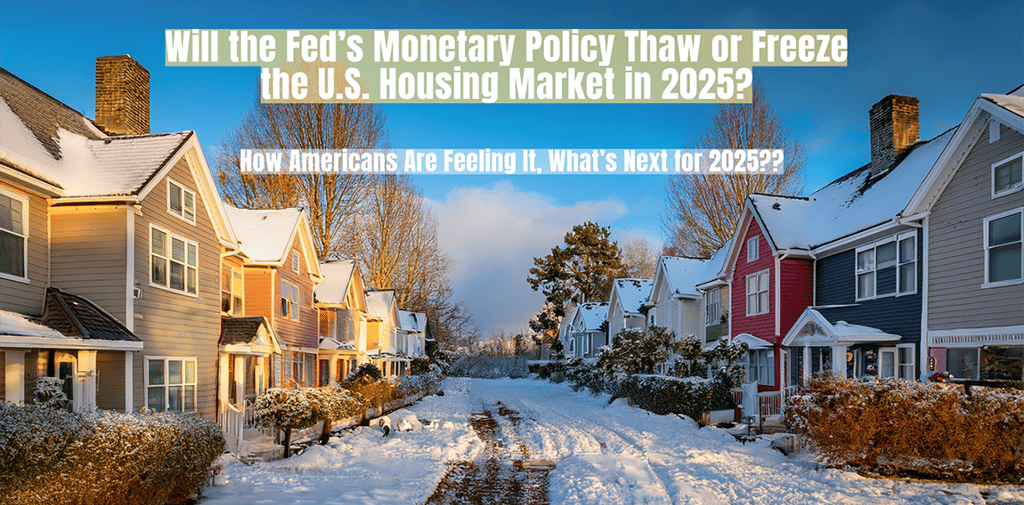Will the Fed’s Monetary Policy Thaw or Freeze the U.S. Housing Market in 2025?
4/22/20253 min read


Will the Fed’s Monetary Policy Thaw or Freeze the U.S. Housing Market in 2025?
The U.S. housing market in April 2025 is stuck in a sluggish crawl, with home prices creeping up at a mere 3% and affordability challenges looming large. High mortgage rates, driven by the Federal Reserve’s monetary policy, are a key culprit, while President Donald Trump’s early policies add complexity. Together, these forces are shaping a market that feels frozen for many Americans. Can the Fed and Trump spark a thaw, or will the chill persist? Let’s unpack the trends, policies, and their impact on your homebuying dreams.
A Market Moving in Slow Motion
The housing market is growing, but it’s barely noticeable. J.P. Morgan Research projects a 3% rise in home prices for 2025, a sharp slowdown from the frenzied days of the early 2020s. Median home prices, now about 5.2 times the median household income, are a major hurdle for first-time buyers. Mortgage rates sit between 6.6% and 7% for a 30-year fixed loan, with forecasts pointing to a slight dip to 6.7% by year-end. Inventory is ticking up—months’ supply reached 4.1, compared to 3.7 in 2024—but a shortage of millions of homes persists, with experts estimating over seven years to close the gap at current construction rates.
For Americans, this means frustration. Young families are trapped in rentals, while homeowners with low-rate mortgages from the pandemic era are reluctant to sell, tightening the supply. The market isn’t crashing or soaring—it’s just stuck.
The Federal Reserve’s Monetary Policy: The Big Driver
The Fed’s monetary policy is the heartbeat of the housing market, directly influencing mortgage rates and affordability:
Interest Rates: After hiking rates in 2022–2023 to tame inflation, the Fed cut the federal funds rate by 50 basis points in late 2024, settling at 4.25–4.5%. However, inflation pressures—partly fueled by Trump’s tariffs—have paused further cuts in early 2025. This keeps mortgage rates high, with a $300,000 loan at 7% costing about $150 more per month than at 6%. High rates are stifling demand, with existing home sales near historic lows.
Inflation Control: Inflation rose to 3.2% in Q1 2025, driven by tariff-related cost increases and strong consumer spending. The Fed, wary of overheating, is signaling a cautious approach. Chair Jerome Powell recently noted robust job growth (unemployment at 3.8%) and tariff uncertainty, suggesting rates may stay elevated to prevent inflation spikes.
Market Impact: High rates discourage borrowing, cooling buyer activity. However, a slight uptick in mortgage applications (up 11% in March 2025) and new home construction (up 11.4% in February) hints at pent-up demand waiting for rate relief.
Trump’s Policies: Amplifying the Fed’s Challenges
Trump’s policies, implemented since January 20, 2025, interact with the Fed’s stance, creating a mixed outlook:
Tariffs: Trump’s tariffs on imports (up to 125% on Chinese goods, 25% on Canadian and Mexican products, partially paused) are driving up construction costs. Lumber and steel price spikes are slowing homebuilding, which indirectly fuels inflation and limits the Fed’s room to cut rates.
Tax Cuts and Deregulation: Extending the 2017 tax cuts and easing zoning regulations aim to boost household budgets and construction. These could increase demand, but if they overstimulate the economy, the Fed might tighten policy to cool inflation, keeping rates high.
Immigration Restrictions: Stricter enforcement could shrink the construction workforce (25% immigrants), raising costs and delaying projects, adding pressure on prices and inflation.
The Fed and Trump are in a delicate dance. Tariffs complicate the Fed’s inflation fight, while tax cuts could force a hawkish response, prolonging high rates and affordability woes.
How Americans Are Feeling It
The Fed’s high-rate environment, amplified by Trump’s policies, hits different groups hard:
First-Time Buyers: A $400,000 home with a 7% mortgage devours over 40% of median incomes, pushing homeownership out of reach. Many are renting longer or eyeing cheaper markets like Raleigh or Boise.
Homeowners: Those with 3% mortgages from 2020–2021 sit on $305 trillion in equity but are “rate-locked,” unwilling to sell and face today’s rates, choking inventory.
Renters: Rents, up 4% year-over-year, are climbing faster with tariff-driven inflation, squeezing budgets in cities like New York and San Francisco.
Regional Variations
Sun Belt states like Texas and Florida see stronger demand due to migration, but tariff costs slow construction. Coastal markets like San Francisco remain unaffordable, with sluggish sales. Smaller cities offer affordability but face inventory shortages.
What’s Next for 2025?
The market’s fate rests on the Fed and Trump. If inflation eases, the Fed could cut rates, lowering mortgage costs and unlocking demand. But persistent tariff-driven inflation may force the Fed to hold firm, worsening affordability. Trump’s deregulation could boost supply long-term, but short-term cost pressures dominate. Buyers might find deals in less competitive markets, while sellers with equity can cash out, but for many, the American Dream feels elusive.
Thought Questions
How are the Fed’s high interest rates affecting your ability to buy or sell a home?
Should the Fed prioritize rate cuts to boost housing affordability, even if it risks inflation?
Can Trump’s policies offset the Fed’s tight monetary stance to revive the housing market?
hello@boncopia.com
+13286036419
© 2025. All rights reserved.